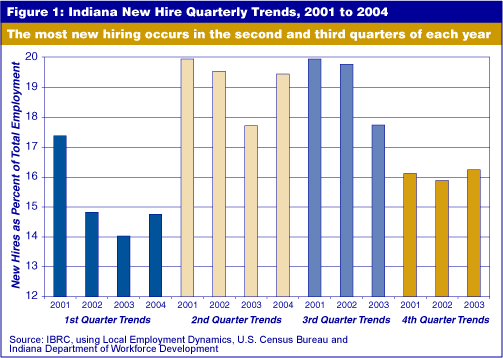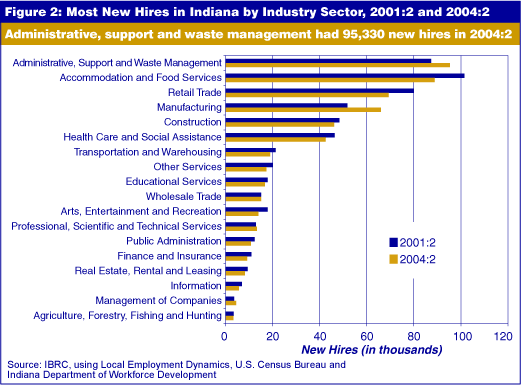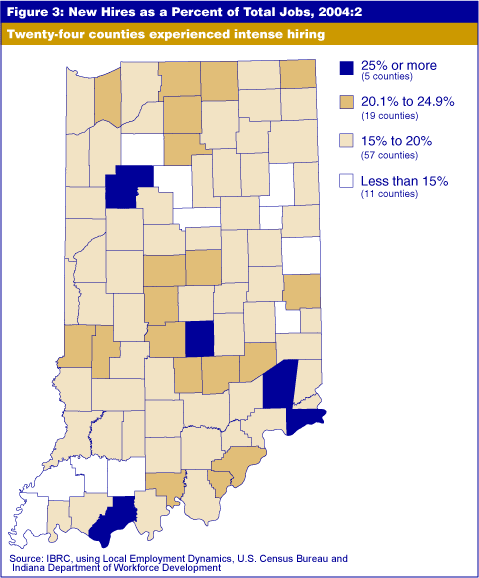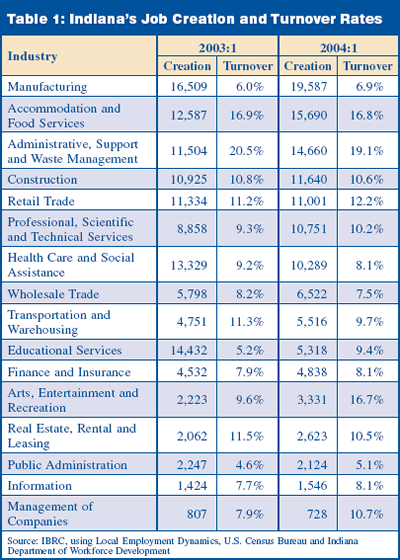New Hires in Indiana
We continue to explore results from the new local employment dynamics data (see the March/April edition of IN Context). Among the items available is new hire data, which is the total number of jobs that were not filled by that employer during the previous four quarters. Focusing on new hires can reveal which industries are hiring the most workers, in what parts of the state, and (useful to job seekers) at what time of the year.
When?
Figure 1 shows new hires by quarter between 2001 and 2004, with the most new hiring occurring in the second and third quarters of each of those years.

Which Industries?
The administrative, support and waste management sector had the largest number of new hires in the second quarter of 2004 (the most recent data available). Overall, retail trade, accommodation and food services, and administrative, support and waste management tend to have the largest number of new hires (see Figure 2).

Where?
It should be obvious that most new hires occur in the most populous areas. So, rather than show the obvious, we look at new hires as a percentage of total jobs in a county to gauge the intensity of new hiring in that area during the second quarter of last year (2004). Twenty-four counties experienced intense new hiring (20 percent or more of their total number of jobs), while the majority of counties (57) had rates of new hiring between 15 percent and 20 percent (see Figure 3).

Two things should be kept in mind when looking at new hires. First, they are not a measure of job creation and second, new hires are offset by job separations. That said, new hire data can be a useful measure for spotting job opportunities and to spot stagnation.
New Hires versus Separations
Job dynamics are what the phrase implies—there is much churning, ebbing and flowing in jobs within businesses and across industry sectors. Some sectors, such as administrative, support and waste management, are balanced with similar numbers of separation and new hires. But other sectors, such as manufacturing and retail, showed many more separations than new hires in the first quarter of 2004. The seasonality of hiring in retail would explain that wide disparity, since one would expect more separations after the holiday season. In manufacturing, such differences might be explained in part by production cycles but could also be the effect of continuing increases in productivity and loss of jobs through attrition or closings of manufacturing plants in the state.
Job Creation and Turnover Rates
The beginning of 2004 saw a significant increase in manufacturing job creation, with nearly 20,000 new jobs in that sector and a low turnover rate of 7 percent. The more volatile accommodation and food services sector and the administrative and support services sector also created many new jobs, but they also had very high turnover rates from 16 percent to nearly 20 percent (see Table 1).

In Conclusion
We will continue to explore the local employment dynamics for Indiana and its counties in future issues of IN Context. You can also explore these data online at https://onthemap.ces.census.gov/. Please let us know if you have questions about this article or the data set by e-mailing us at ibrc@iu.edu.
Carol O. Rogers
Associate Director, Indiana Business Research Center,
Kelley School of Business, Indiana University
